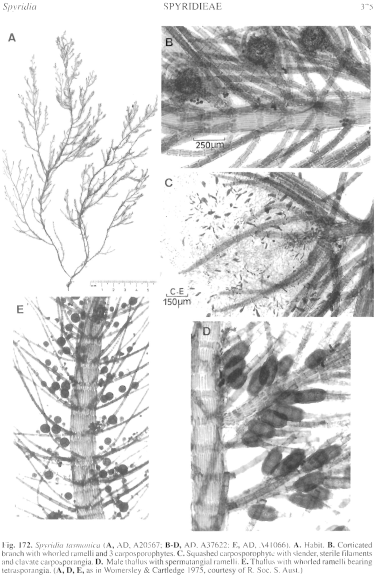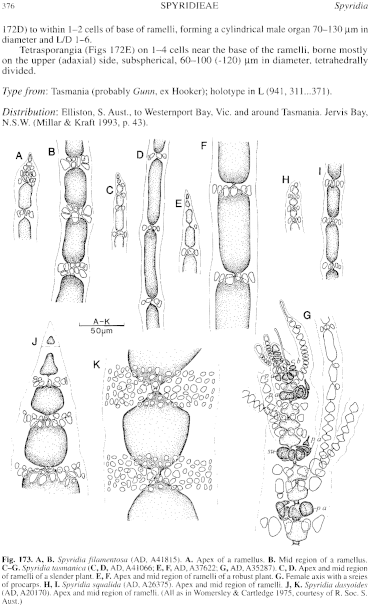|
|
|
|
|
|||||||||||
|
Electronic Flora of South Australia Species Fact Sheet
Phylum Rhodophyta – Order Ceramiales – Family Ceramiaceae – Tribe Spyridieae
Selected citations: Gordon 1972: 39. Harvey 1859b: 329. Kützing 1862: 14, pl. 42c, d. Millar & Kraft 1993: 43. Sonder 1853: 680. Womersley & Cartledge 1975: 227, figs 2, 3C–G, 4A–C.
Synonyms
S. filamentosa var. tasmanica Kützing 1849: 666.
S. filamentosa var. verticillata Harvey 1844: 449.
Wrangelia setigera Harvey 1859b: 309, pl. 191A; 1863, synop.: xxvii. J. Agardh 1876: 622; 1879: pl. 32, fig. 3. De Toni 1897: 133; 1924: 149. Gordon 1972: 39. Guiler 1952: 99. Lucas 1909: 23; 1929a: 16. May 1965: 365. Mazza 1919, No. 678. Okamura 1932: 133. Sonder 1881: 29. Tisdall 1898: 511. Wilson 1892: 170.
Thallus (Fig. 172A) grey-red to red-brown, usually 8–25 cm high, much branched irregularly alternately, branches terete, with one to a few main axes and prominent lateral branches, bearing lesser branches on all sides, with whorled ramelli. Holdfast small, discoid; epilithic or on Amphibolis. Structure. Axes 1–2.5 (–2) mm in diameter, lesser branches 200– 400 µm in diameter, segments L/D (0.5–) 0.8–1.3 (Fig. 172B, E) with usually 12 periaxial cells, each producing two internodal cells; cortication by rhizoidal cells from the nodal cells, commencing within 1–2 cm of apices but becoming thick on axes and main branches. Ramelli 1 (–3) per node near apices, becoming whorled (Fig. 172B, E) with 3–6 (–8) per whorl with the addition of adventitious ramelli, arising from enlarged periaxial cells, 0.7–2 (–3) mm and 20–30 (–35) cells long, largest cells (15–) 20–35 (–40) µm in diameter and L/D (1.5–) 3–5, the end cell mucronate (Fig. 173C, E); ramelli (Fig. 173D, F) with a single row of 8–14 nodal cells. Cells uninucleate; rhodoplasts discoid to elongate, becoming ribbon like,
Reproduction: Gametophytes dioecious. The female axes (Fig. 173G) arising as short laterals, bearing up to 5 procarps separated by one or two sterile segments, each with eight periaxial cells, one of which bears a ramellus. Each procarp (Fig. 173G) consists of 3 (rarely 4) periaxial cells, one the supporting cell bearing a 4-celled carpogonial branch. Usually two gonimolobes develop, probably from fusion cells originating from auxiliary cells cut off from the supporting cell and one of the other fertile periaxial cells. Sterile pericarp filaments arise (Fig. 172C) from the periaxial cells of segments above and below the procarp-bearing segment, forming a involucre similar to that in S. filamentosa. Carposporophytes (Figs 172B, C) terminal on a short branchlet bearing ramelli, 0.5–0.8 mm across. Spermatangia cover 2–6 cells (Fig.
Type from: Tasmania (probably Gunn, ex Hooker); holotype in L (941,311...371).
Selected specimens: Cliff Head, W. Aust., 5–6 m deep (Kirkman & Jolt, 18.ix.1979; AD, A51187). Elliston, S. Aust., 7 m deep in bay (Shepherd, 20.x.1970; AD, A37622). N Spencer Gulf, S. Aust., 10 m deep (Shepherd, 13.ix.1973; AD, A44316). Investigator Strait, S. Aust., 35 m deep (Watson, 14.i.1971; AD, A38210) and 33 m deep (Watson, 24.i.1971; AD, A41066). Outside Tapley Shoal, Gulf St Vincent, S. Aust., 15 m deep (Shepherd, 2.ii.1969; AD, A33538). 5 km W of Port Noarlunga, S. Aust., on shells, 21 m deep (Ottaway, 8.xii.1980; AD, A52128). American R. inlet, Kangaroo I., S. Aust., upper sublittoral (Womersley, 23.viii.948; AD, A8562). Cape Lannes, Robe, S. Aust., in shaded pool (Kraft, 10.ii.1973; AD, A46223). Portarlington, Vic., drift (Wollaston, 17.viii.1956; AD, A20567). Crawfish Rock, Westernport Bay, Vic., 5–6 m deep (Watson, 28.v.1974; AD, A45422). Missionary Bay, Bruny I., Tas., 6–8 m deep (Womersley, 15.i.1949; AD, A10182).
Distribution: Elliston, S. Aust., to Westernport Bay, Vic. and around Tasmania. Jervis Bay, N.S.W. (Millar & Kraft 1993, p. 43).
Taxonomic notes: 172D) to within 1–2 cells of base of ramelli, forming a cylindrical male organ 70–130 µm in diameter and L/D 1–6.
Tetrasporangia (Figs 172E) on 1–4 cells near the base of the ramelli, borne mostly on the upper (adaxial) side, subspherical, 60–100 (–120) µm in diameter, tetrahedrally divided.
S. tasmanica is a distinctive species with its whorled ramelli and single row of nodal cells. It occurs generally in relatively calm localities, often with considerable current, 2–35 m deep, occasionally in partly sheltered habitats and shaded rock pools on rough-water coasts.
References:
AGARDH, J.G. (1852). Species Genera et Ordines Algarum. Vol. 2, Part 2, pp. 337–720. (Gleerup: Lund.)
AGARDH, J.G. (1876). Species Genera et Ordines Algarum. Vol. 3, Part 1- Epicrisis systematic Floridearum, pp. i-vii, 1–724. (Weigel: Leipzig.)
AGARDH, J.G. (1879). Florideernes morphologi. K. Svenska Vetensk. Akad. Handl. 15(6), 1–199, Plates 1–33.
DE TONI, G.B. (1897). Sylloge Algarum omnium hucusque Cognitarum. Vol. 4. Florideae. Sect. 1, pp. 1–388. (Padua.)
DE TONI, G.B. (1924). Sylloge Algarum omnium hucusque Cognitarum. Vol. 6. Florideae. (Padua.)
GORDON, E.M. (1972). Comparative morphology and taxonomy of the Wrangelieae, Sphondylothamnieae and Spermothamnieae (Ceramiaceae, Rhodophyta). Aust. J. Bot. suppl. 4, 1–180.
GUILER, E.R. (1952). The marine algae of Tasmania. Checklist with localities. Pap. Proc. R. Soc. Tasmania 86, 71–106.
HARVEY, W.H. (1844). Algae of Tasmania. Lond. J. Bot. 3, 428–454.
HARVEY, W.H. (1859b). Algae. In Hooker, J.D., The Botany of the Antarctic Voyage. III. Flora Tasmaniae. Vol. II, pp. 282–343, Plates 185–196. (Reeve: London.)
HARVEY, W.H. (1863). Phycologia Australica. Vol. 5, Plates 241–300, synop., pp. i-lxxiii. (Reeve: London.)
KÜTZING, F.T. (1849). Species Algarum. (Leipzig.)
KÜTZING, F.T. (1862). Tabulae Phycologicae. Vol 12. (Nordhausen.)
LUCAS, A.H.S. (1909). Revised list of the Fucoideae and Florideae of Australia. Proc. Linn. Soc. N.S.W. 34, 9–60.
LUCAS, A.H.S. (1929a). The marine algae of Tasmania. Pap. Proc. R. Soc. Tasm. 1928, 6–27.
MAY, V. (1965). A census and key to the species of Rhodophyceae (red algae) recorded from Australia. Contr. N.S.W. natn. Herb. 3, 349–429.
MAZZA, A. (1919). Aggiunte al Saggio di Algologia Oceanica. (Florideae). Nuova Notarisia 30, Nos. 661–683.
MILLAR, A.J.K. & KRAFT, G.T. (1993). Catalogue of marine and freshwater Red Algae (Rhodophyta) of New South Wales, including Lord Howe Island, South-western Pacific. Aust. Syst. Bot. 6, 1–90.
OKAMURA, K. (1932). The distribution of marine benthic algae in Pacific waters. Rec. Océanogr. Works Jap. 3, 30–150.
SONDER, O.W. (1853). Plantae Muellerianae. Algae. Linnaea 25, 657–709.
SONDER, O.W. (1881). In Mueller, F., Fragmenta Phytographiae Australiae. Supplementum ad volumen undecinum: Algae Australianae hactenus cognitae, pp. 1–42, 105–107. (Melbourne.)
TISDALL, H.T. (1898). The algae of Victoria. Rep. 7th Meet. Aust. Ass. Adv. Sci., Sydney, 1898, pp. 493–516.
WILSON, J.B. (1892). Catalogue of algae collected at or near Port Phillip Heads and Western Port. Proc. R. Soc. Vict. 4, 157–190.
WOMERSLEY, H.B.S. & CARTLEDGE, S.A. (1975). The southern Australian species of Spyridia (Ceramiaceae, Rhodophyta). Trans. R. Soc. S. Aust. 99(4), 221–234.
The Marine Benthic Flora of Southern Australia Part IIIC complete list of references.
Publication:
Womersley, H.B.S. (24 December, 1998)
The Marine Benthic Flora of Southern Australia
Rhodophyta. Part IIIC. Ceramiales – Ceramiaceae, Dasyaceae
©State Herbarium of South Australia, Government of South Australia
Illustrations in Womersley Part IIIA, 1998: FIGS 172, 173 C–G.

Figure 172 enlarge
Fig. 172. Spyridia tasmanica (A, AD, A20567; B–D, AD, A37622; E, AD, A41066). A. Habit. B. Corticated branch with whorled ramelli and 3 carposporophytes. C. Squashed carposporophyte with slender, sterile filaments and clavate carposporangia. D. Male thallus with spermatangial ramelli. E. Thallus with whorled ramelli bearing tetrasporangia. (A, D, E, as in Womersley & Cartledge 1975, courtesy of R. Soc. S. Aust.)

Figure 173 enlarge
Fig. 173. A, B. Spyridia filamentosa (AD, A41815). A. Apex of a ramellus. B. Mid region of a ramellus. C–G. Spyridia tasmanica (C, D, AD, A41066; E, F, AD, A37622; G, AD, A35287). C, D. Apex and mid region of ramelli of a slender plant. E, F. Apex and mid region of ramelli of a robust plant. G. Female axis with a sreies of procarps. H, I. Spyridia squalida (AD, A26375). Apex and mid region of ramelli. J, K. Spyridia dasyoides (AD, A20170). Apex and mid region of ramelli. (All as in Womersley & Cartledge 1975, courtesy of R. Soc. S. Aust.)

|
Email Contact: State Herbarium of South Australia |

|